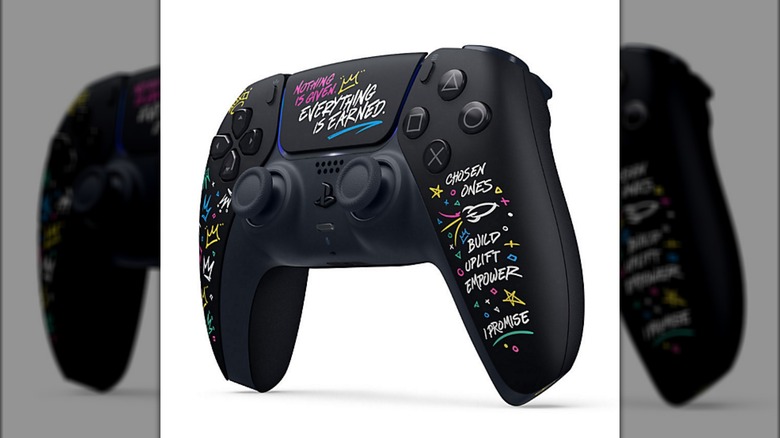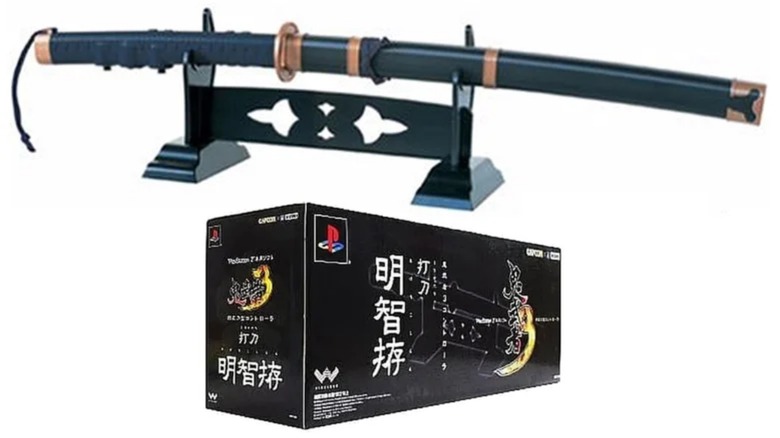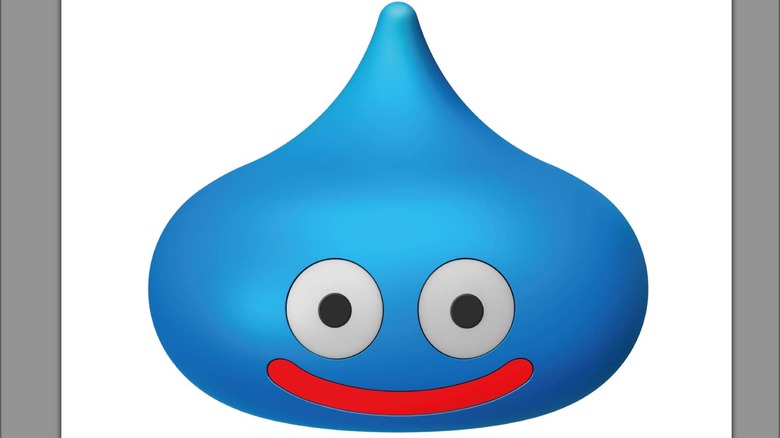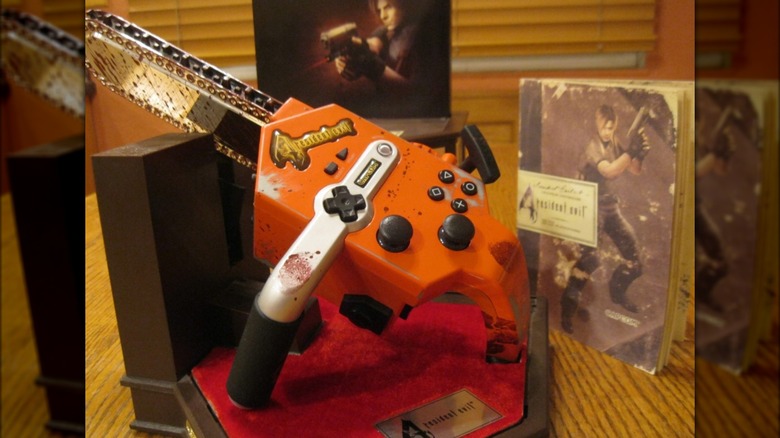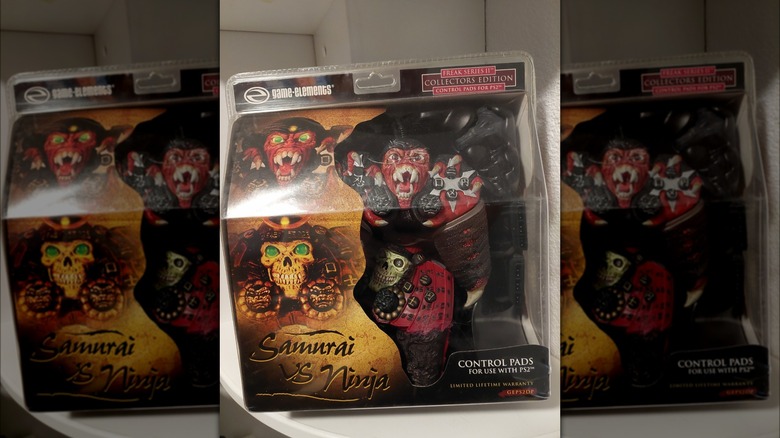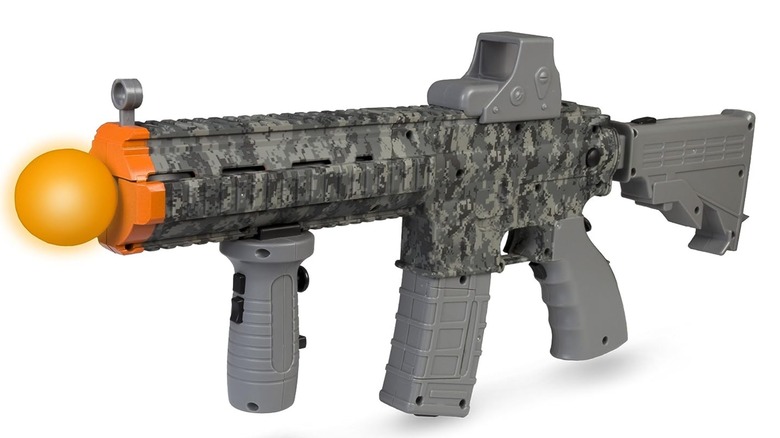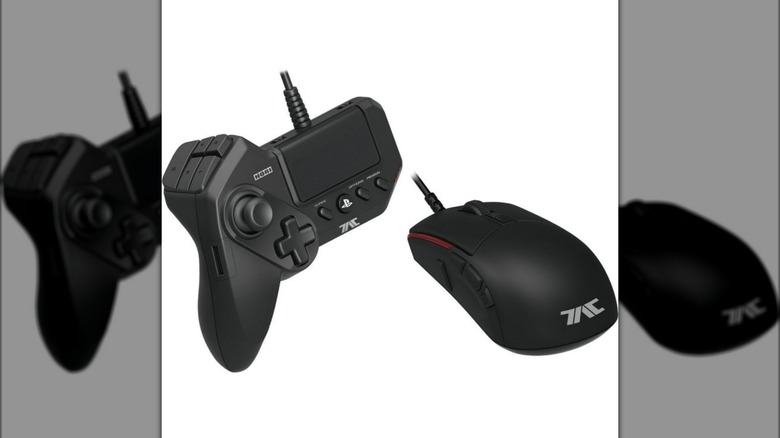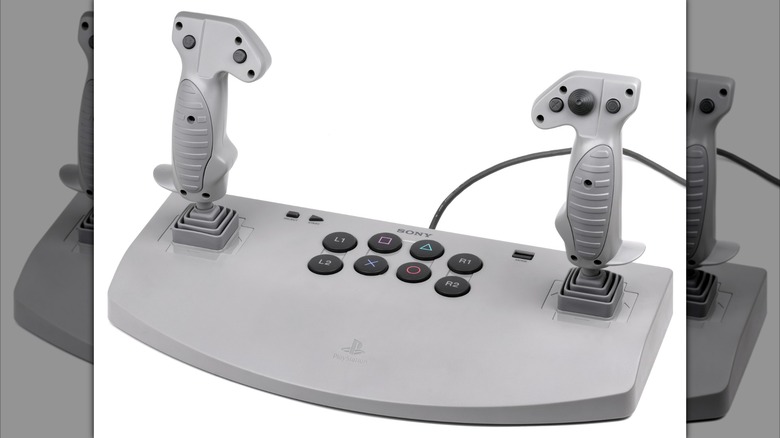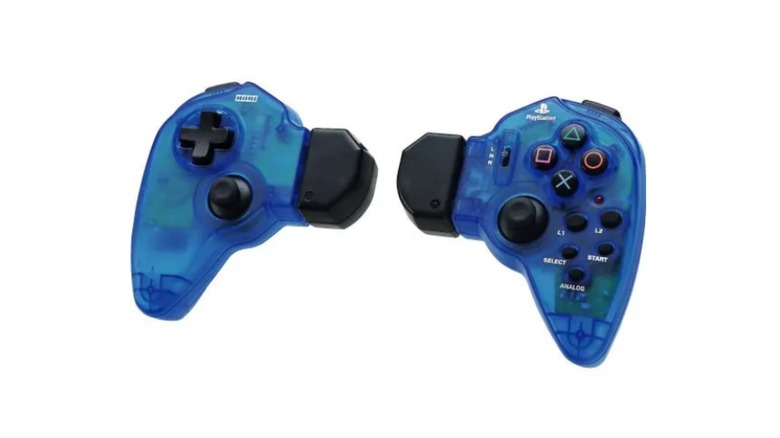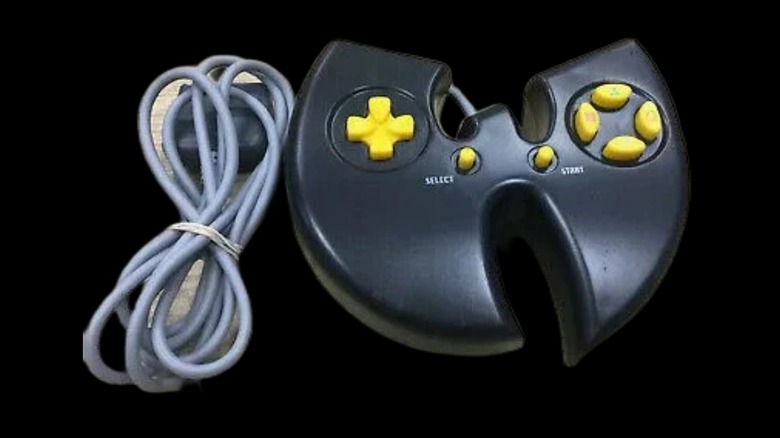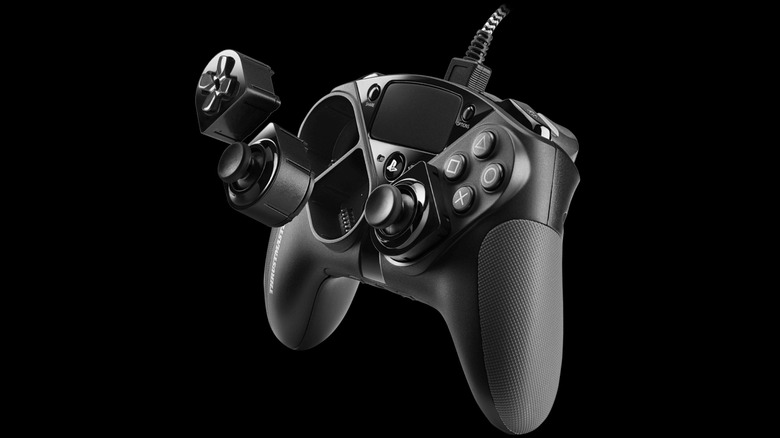10 Strangest PlayStation Controllers We've Ever Seen
Over time, video game controllers have gone through many iterations, although specific alterations depend on the manufacturer. For instance, Nintendo controllers vary wildly between console generations, whereas Sony's PlayStation controllers have mostly stayed the same, minus the occasional color swap and addition of features such as rechargeable batteries. Quite frankly, the DualSense controller's dual-tone colors mark the first time Sony moved outside its comfort zone, but not the first time PlayStation controllers deviated from the iconic dual-pronged shape.
Throughout the PlayStation's history, Sony has granted numerous third party manufacturers permission to produce official controllers. Many results stuck to the basic schematic, but more than a few were designed to attract potential buyers by making them ask, "What the heck am I looking at?" Some covered the iconic PlayStation controller shape in edgy details designed to attract rebellious teens, while others twisted the recognizable form like taffy until it was unrecognizable. And while these examples are all functional as controllers, sometimes these alterations came at the cost of ergonomics.
Here are some of the absolute strangest handhelds to grace a PlayStation console, although admittedly some are better used as game room decorations than actual controllers.
Katana Controller
If you ever visited a video arcade, you might have seen a Namco game called "Mazan: Flash of Blade." This game stands out since it is technically a "light gun" game, but instead of shooting a plastic gun at a screen, you wave around a plastic katana and pretend you're dueling zombie samurai. Capcom had the same idea but turned the fake katana into a controller.
Capcom went all out to create "Onimusha 3: Demon Siege," and went so far as to hire Jean Reno to portray one of the game's characters. Capcom also commissioned HORI to produce a katana-shaped controller. Well, technically the controller is shaped like a katana hilt — all the components are held in the rubberized grip. The rest of the katana, including the blunt plastic "blade" and sheath, are extra and detachable. But without them, the katana controller wouldn't look complete, especially since it includes a plastic display stand that mirrors those of real katanas.
Since the controller is a straight shaft, holding and using the controller is a nightmare because of how the buttons are arranged. While this can be mitigated by swinging the controller like an actual sword to activate motion controls, the end result is certainly janky. It was expensive gimmick that is worth a lot of money today, but a gimmick nonetheless.
Slime Controller
Many people like purchasing merchandise related to their favorite movies and shows, and that rule also applies to gamers. Many video game enthusiasts collect products associated with games they love, and the longer a franchise's lifespan, the more merch it usually produces. "Dragon Quest" has been around since 1986 and is home to tons of action figures, props, and even a few odd controllers.
To celebrate the release of "Dragon Quest XI: Echoes of an Elusive Age," HORI produced an officially licensed PlayStation 4 controller in the form of the "Dragon Quest" franchise's mascot, the goop-tacular slime. The accessory features a rubberized surface that faithfully recreates the slime's shape, smiling face, and bright-blue hue. The PS4 controller's buttons, meanwhile, are stored on the slime's bottom. This controller also includes a display stand.
Unfortunately, since this controller is focused on copying the slime's size and shape, it doesn't have the same ergonomics as a regular controller and is thus difficult to hold. That isn't to say HORI's slime controller is badly designed — especially compared to other controllers in this list — just that it makes for a better decoration than a controller. Regardless, HORI recycled this idea to make another slime-shaped controller for the Nintendo Switch port of "Dragon Quest XI."
Chainsaw Controller
Every "Resident Evil" game features a mascot monster. For "Resident Evil 3: Nemesis," it's the titular Nemesis, and for "Resident Evil 2," it's a toss up between Mr. X and G-Birkin. The face of "Resident Evil 4," meanwhile, is the masked Dr. Salvador and his deadly chainsaw. Since Dr. Salvador is the bane of many playthroughs, why not cathartically turn his weapons on other Ganados and Las Plagas?
When Capcom released "Resident Evil 4," the company collaborated with NubyTech to produce a chainsaw-shaped controller. Unfortunately, the peripheral was designed with form over function. The device technically works, but its buttons are laid out in hand-cramping locations. For an added layer of intrigue, the blood spatters that decorate the controller are applied randomly, so no two chainsaws are the same.
Since "Resident Evil 4" was originally developed for the Nintendo Gamecube, the chainsaw controller was created with that console in mind. When Capcom ported the game to PlayStation 2, a PS2-compatible chainsaw inevitably followed close behind. The PS2 variant obviously sports the appropriate buttons, as well as a red paint job. Ironically, while the PS2 port of "Resident Evil 4" is graphically inferior to the Gamecube original, its chainsaw controller is the superior peripheral, if only because it adds a ripcord that triggers chainsaw noises.
Freak Series Controllers
During the 1990s and 2000s, "edgy" and "extreme" were flavors of the day. Child and teen-oriented products required a rebellious attitude, especially if they were video games or video game adjacent. Many new IPs reflected this mindset, and several established characters were reenvisioned to fit this trend.
While third-party manufacturers have been selling alternative video game controllers ever since, well, video games were invented, one of the oddest belonged to Game Elements (or Gemini Industries). The company produced numerous "normal" controllers, but its most eye-catching were the Freak Series. These controllers were designed for Xbox and PlayStation 2 (but not Gamecube) and sported gnarly details. While modern controllers feature tampographed patterns, Freak controllers were brought to life with carefully molded details.
Game Elements produced wicked controllers in the shape of a dragon and alien for the Xbox, but the PlayStation 2 got way more love. The company sold a gruesome zombie-themed controller with an exposed brain and a red vein-like connector cord, a demonic controller with horns for holding prongs and eyes for thumbsticks, as well as Samurai and Ninja controllers. The latter two feature characters on the face buttons and light-up eyes, and the Samurai's faceplate detaches to reveal a skeletal face worthy of a Meat Loaf or Iron Maiden record cover.
While Game Element's controllers are the result of a bygone era of attitude, they have way more character than most special controllers produced today.
Gun Controllers
Some politicians claim video games are directly responsible for increases in gun violence. Othes think that video games actually teach children how to properly handle guns. While a negligible number of studies have discovered direct correlations or causations between video games and violence (but some discovered a link between violent video games and improved eyesight), ironically several video game controllers are shaped like actual guns, and I'm talking about the NES Zapper.
Several manufacturers have produced PlayStation peripherals in the form of assault rifles. These include the Delta 6, the EK-86, and the U.S. Army Elite Force Assault Rifle Controller. The latter two were designed for the PlayStation 3, specifically the PlayStation Move, while the former was intended for modern platforms such as the PlayStation 4. Moreover, the U.S. Army Elite Force Assault Rifle Controller isn't just a name; it was officially licensed by the U.S. Army.
While different companies manufactured these fake firearms, each shared many design choices, such as placing thumbsticks and "face" buttons near the thumbs, as well as mapping the fire button to the gun trigger. The Delta 6 even includes simulated recoil. While most of these controllers were designed for lightgun games, they are compatible with other titles. You probably wouldn't want to play "Batman: Arkham City" with these controllers, but they are right at home in gun-oriented games such as "Borderlands 2."
HORI PS4 TAC Grip
What is the best control scheme for a video game? It depends on the genre. For shooters, most gamers prefer a mouse and keyboard over controllers. While you can attach a mouse and keyboard to a PlayStation 4 for better aiming control, doing so sacrifices the preciseness of moving with an analog stick. But to quote the little girl from the Old El Paso taco commercial, "Why don't we have both?" Because it looks weird, that's why.
HORI has shown up numerous times on this list, but the company's strangest controllers belong to its Tactical Assault Commander line, or TAC for short. Recent iterations such as the TAC 4 are miniature keyboards linked to mice; ill-suited for playing MMOs like "Final Fantasy XIV," but perfect for FPS titles such as "Apex Legends." However, these controllers are positively normal compared to other HORI offerings.
Before HORI started producing mini keyboards for PlayStation, it sold the PS4 TAC Grip. Like the TAC 4, this peripheral maps all right analog stick movements to a mouse, but instead of hooking it up to a keyboard, the TAC Grip's mouse plugs into half a demi-Dualsense controller. The "controller" portion of the TAC grip has a d-pad and an analog stick, except they use the Xbox controller layout, which is just as weird as seeing a Dualsense-shaped controller missing its second prong, face buttons, and right analog stick. Sure, all the buttons are on the mouse, but at the end of the day, the TAC Grip looks like some weird custom controller, only it's officially licensed.
PlayStation Analog Joystick
To call the original Dualshock controller a success would be an understatement. While the Dualshock wasn't the first controller to use an analog stick, it was the first handheld peripheral to use two of them. But the devil is in the details. The Dualshock sported two analog sticks before any other portable controller, but it wasn't the first controller to experiment with two sticks.
Sony's PlayStation Analog Joystick might not sport as creative a name as the Dualshock, but it was the company's first stab at controllers with two analog sticks. The Analog Joystick is as large as an arcade fight stick, and instead of two nubs users manipulate with their thumbs, the controller sports two long handles, not unlike those you see on PC flight simulator slight sticks. To add to the similarities, the PlayStation Analog Joystick includes two sets of buttons. Both function the same as normal PlayStation buttons, except one set is located on the controller's sizable base like a fight stick, while the other is split between the two flight sticks.
Unlike other PlayStation controllers, the PlayStation Analog Joystick lacks a d-pad, and not every OG PS game is compatible with the controller. Still, without the PlayStation Analog Joystick, dual-stick controllers might have required a bit more experimentation before future designs were finalized.
HORI Separate Controller
Most video game controllers are designed to be held with two hands. This design is so ingrained in gamers' minds that alterations feel wrong. However, if you can hold half a controller in each hand, that would still work, right? HORI thought so.
The HORI Separate Controller was designed exclusively for the Japanese PlayStation 2 market. At first glance, it looks like your average third-party controller, but true to its name, the Separate Controller can separate into two halves of a peripheral, one for each hand. This mode requires a specialized cable (which comes with the device) and sounds like an odd design choice, but if you ever had your arm in a sling or cast, you know how hard it is to hold a solid game controller when one arm is literally pinned in position.
While the Separate Controller's ability to split like a Joy Con — several decades before that controller was invented, mind you — sounds like a neat gimmick, it's not the HORI Separate Controller's only trick. The device has a third mode that lets gamers use it with one hand, but this feature takes some getting used to since it relies on a toggleable switch. The HORI Separate Controller's one-handed mode is nowhere near as elegant as the one-handed controllers other companies produced for subsequent consoles, but at least it demonstrated that HORI was showing initiative and producing peripherals with accessibility in mind.
Wu-Tang: Shaolin Style Controller
Musicians are no strangers to the world of video games. Harmonix made serious bank by converting countless popular songs into rhythm-based party game tracks, and "50 Cent: Blood on the Sand" was way better than anyone expected. Long before those games, the Wu-Tang clan backed their own tie-in title that came packed with a limited edition controller. Neither were worth owning, though.
To help advertise the game "Wu-Tang: Shaolin Style," PlayStation bundled a controller in the shape of the Wu-Tang Clan's "W" symbol with every Special Edition copy. However, the controller is bare bones. This peripheral lacks rumble and analog sticks, even though the controller's lower portions have more than enough room to fit them. Moreover, "Wu-Tang: Shaolin Style" released in 1999, two years after the Dualshock controller. The limited-edition controller was seriously behind the times.
Because of the Wu-Tang: Shaolin Style controller's awkward form and oddly shaped buttons, the device cramps hands with ease. To make matters worse, its source material game was poorly reviewed at launch, and reviewers never eased up on it. In a weird cosmic sort of way, it kind of makes sense that a bad game would be bundled with a bad controller.
eSwap Pro Controller
Functionally, very little separates PlayStation controllers and Xbox controllers. Not counting differences in overall shape and console compatibility, the only major difference is joystick placement. Xbox controllers place their left joystick across from the face buttons, while PlayStation controllers put their left joystick next to the right joystick. But what if that rule wasn't set in stone?
Thrustmaster's line of eSwap Pro Controllers are designed around customization. While each includes all the standard face buttons, analog sticks, and shoulder triggers, users can swap most of these tactile interfaces out with module packs that come in a variety of colors and patterns. The only aspects players can't change are the controllers' compatibility; an eSwap PS4 Pro Controller won't work on an Xbox and vice versa.
The eSwap is unusual not because of how it looks but because of how users can make it look. Every module is compatible in every other module slot, which can result in weird combinations. Want a PS4 controller with the joystick layout of an Xbox controller? You can make one. What about a controller with three joysticks and no d-pad, or three d-pads and no joysticks? Again, that layout is possible. You can also mix and match module colors to create a patchwork quilt of plastic buttons and levers. So long as you have the money to buy all the modules you want, you can make an eSwap Pro Controller look as weird or normal as you want.
